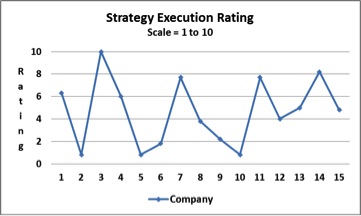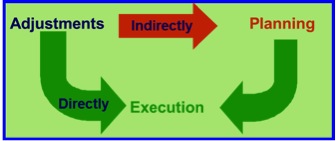Putting the Information and the Plan Into Action: Execution Stage

It may be the last stage of the strategic process, but it’s the most important. You’ve spent significant time and effort developing market intelligence and building a plan, but a poorly written plan that’s well executed is still more successful than a good plan that is poorly executed. In the third of our 3 part series on planning we cover the execution stage.
It’s normal at this time for your team to be tired and lose focus on this phase. The fun brainstorming and planning stages are over. Execution is work, very hard work. Providing adequate support, plenty of encouragement and valuable rewards will help make this stage a success. Any part of the process that is handled poorly will only hinder progress in the future.
Below is a graph showing how 15 companies rated the execution portion of their strategic planning/implementation process. The average rating was 4.7 out of a possible 10.0, leaving loads of room for improvement in the execution stage of this process.

Information
There are some key pieces of information and answers to questions that should be used throughout the execution process.
- What is the strategy? Why did we adopt it? How does it benefit the stakeholders?
- A plan roadmap that outlines strategic objectives and the execution steps
- Milestone data, including: finances (current and projected), operations and new market information
- Change orders that may arise out of receiving new market intelligence
The execution stage of a project will likely be more drawn out than the first two steps. Keeping this information current and at hand will help your group stay involved, committed and focused on the mission. It will also help to keep everyone in the loop and resolve issues as they arise.
Action
The plan roadmap can be used to guide and coordinate change within and between different business units and groups. Milestone data can be used to provide progress reports and determine if any adjustments are needed to the roadmap. Change orders can be received and implemented.
Below is the Feedback Loop portion of the Strategy Process Wheel:

Adjustments
Utilizing the Feedback Loop will come into play when adjustments need to be made. If you’re not meeting your goals, it’s time to ask specific questions – Did you miss something in your market intelligence? Was the planning process faulty? Going back and taking a critical look at what’s been done, or doing further research, will help to rectify missteps.
When tackling any type of project or implementing a significant plan, it’s important to have the right team in place and communicate with clear directives. A thorough strategic process is a good indication of some key areas of discipline that are needed to reach your goals. When you combine that with a decent business model, you will be well prepared for success.
Miss the first article in this series? Take a look now at Preparing A Strategic Plan – Kicking Off Your Planning Process.
Identify your path to CFO success by taking our CFO Readiness Assessmentᵀᴹ.
Become a Member today and get 30% off on-demand courses and tools!
For the most up to date and relevant accounting, finance, treasury and leadership headlines all in one place subscribe to The Balanced Digest.
Follow us on Linkedin!
